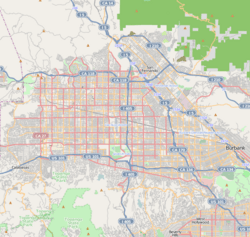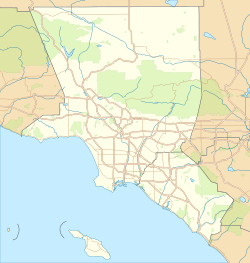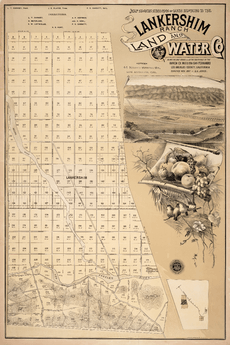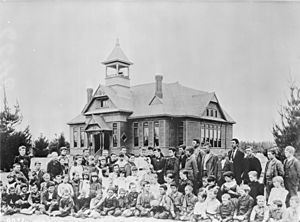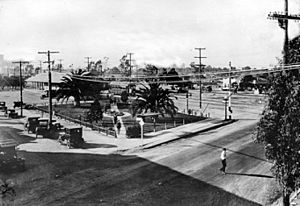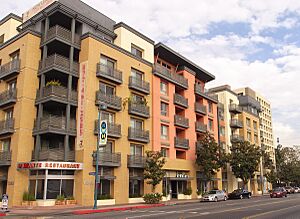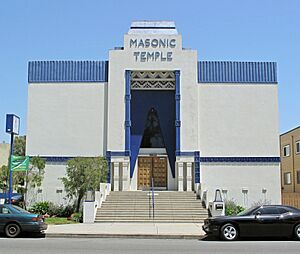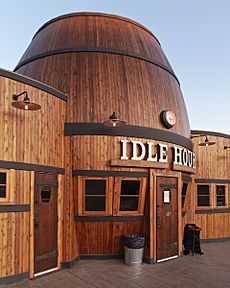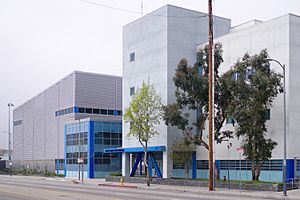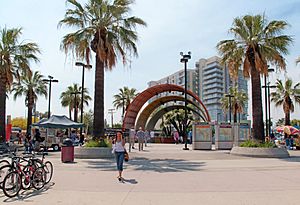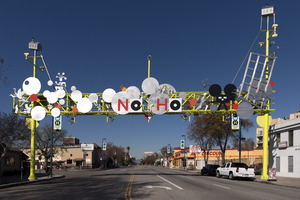North Hollywood, Los Angeles facts for kids
Quick facts for kids
North Hollywood
|
|
|---|---|
|
Top: St. Charles Borromeo Church (left), North Hollywood High School (right); bottom: El Portal Theater (left), Academy of Television Arts & Sciences (right).
|
|
| Nickname(s):
NoHo
|
|
| Country | United States of America |
| State | California |
| County | Los Angeles |
| City | Los Angeles |
| Named for | Location north of Hollywood |
| Population
(2024)
|
|
| • Total | 64,587 |
North Hollywood is a lively neighborhood in the San Fernando Valley of Los Angeles, California. It's known for its creative side, especially the NoHo Arts District. Here you'll find places like the El Portal Theater and many art galleries. It's also home to the Academy of Television Arts & Sciences.
This area is a major transportation hub. The North Hollywood Metro Rail station is where the B Line subway starts.
North Hollywood began in 1887. It was first called "Toluca," then "Lankershim" in 1896, and finally "North Hollywood" in 1927.
History of North Hollywood
North Hollywood has a long and interesting past. It was once part of a huge area owned by the Mission San Fernando Rey de España. Later, the government took over this land.
Early Days and Farming
A group of investors bought the southern part of the Rancho Ex-Mission San Fernando. One main investor was Isaac Lankershim, who wanted to raise sheep there. In 1873, his son, James Boon Lankershim, and his son-in-law, Isaac Newton Van Nuys, took charge. Van Nuys believed they could grow wheat using a special farming method. Soon, their company became the world's largest wheat farm.
In 1887, J.B. Lankershim and others created the Lankershim Ranch Land and Water Company. They bought a large piece of land north of the Cahuenga Pass. Lankershim started a town called Toluca. They sold small farms already planted with fruit and nut trees. These trees could survive dry summers by using underground water.
Even after a tough time for land sales in the 1890s, the fruit and nut farmers did well. In 1894, the Toluca Fruit Growers Association was formed. A train line opened nearby, with a stop called Lankershim. People were confused because the town's post office was still called Toluca. In 1896, the post office was renamed "Lankershim."
By 1903, the area was famous for its peaches. A big fruit company canned millions of tons of fruit. In 1913, the Los Angeles Aqueduct opened, bringing water to Los Angeles. Farmers wanted to buy this extra water, but a law stopped Los Angeles from selling it outside the city.
Joining Los Angeles
Farmers first resisted joining Los Angeles. But fruit packing companies and Los Angeles businesses worked together to lower fruit prices. This made it hard for farmers to make money. When droughts hit again, many farmers had to give up their land. These lands were then bought by real estate developers.
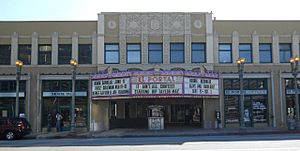
In 1919, West Lankershim joined Los Angeles. The rest of Lankershim followed in 1923. Much of the promised water never arrived. Many farms were taken over by packing companies, then by developers. To make the area more appealing, Lankershim was renamed "North Hollywood" in 1927. This helped turn the area into a growing suburban part of Los Angeles.
Shopping and Changes Over Time
Lankershim Boulevard was once the main shopping area in North Hollywood. It had many stores, banks, and restaurants until the mid-1950s. For example, in 1953, it had several department stores and other shops.
Later, big shopping centers like Valley Plaza opened. These centers were designed for people who drove cars. They made it hard for the older shopping district to compete. By 1980, many stores on Lankershim Boulevard had closed. Today, parts of Valley Plaza are empty or have been turned into other things, like a middle school.
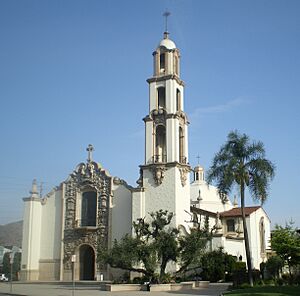
In the late 1950s, many original families moved away. New families moved in, changing the area's population. By the 1990s, North Hollywood had become very diverse.
In 1997, a serious event called the North Hollywood shootout happened. It involved a confrontation between police and two armed robbers.
North Hollywood Today
The opening of the North Hollywood station in 2000 helped bring new life to the area. The NoHo Arts District also became very popular. Old areas like Laurel Plaza are being redeveloped into new mixed-use spaces.
Since 2000, North Hollywood has been growing and changing a lot. This is thanks to projects like the North Hollywood Development District. In 2015, Lankershim Boulevard was part of CicLAvia. This event closes major roads to cars, letting people walk or bike freely.
Geography and Climate
North Hollywood is surrounded by several other Los Angeles neighborhoods. To the north is Sun Valley. Burbank is to the northeast and east. Toluca Lake is to the southeast and south. Studio City is to the southwest. To the west are Valley Village and Valley Glen.
It's important to know that North Hollywood is not directly next to Hollywood. It's about 6 miles (10 km) north of Hollywood.
North Hollywood has a hot summer Mediterranean Climate. This means it has hot, dry summers and mild, wet winters.
People and Community
In 2000, North Hollywood had about 77,848 residents. This means about 13,264 people lived in each square mile. The average age of residents was 30. Many people aged 19 to 34 lived here.
The neighborhood is known for being "moderately diverse." About 57.7% of residents were Latino, 27% were Non-Hispanic White, 5.7% were Asian, and 5.6% were Black. Many residents (46.4%) were born outside the U.S., mainly from Mexico and El Salvador.
The average household income in 2008 was about $42,791. Most people (75.4%) rented their homes or apartments.
Fun Things to Do
Local Attractions
North Hollywood has several interesting places to visit:
- The Academy of Television Arts & Sciences
- El Portal Theater
- Idle Hour Cafe
- Phil's Diner
- NoHo Gateway Sign
- Valhalla Memorial Park Cemetery
Parks and Recreation
North Hollywood has great parks for sports and fun. The North Hollywood Recreation Center has an auditorium, baseball fields, basketball courts, and a children's play area. It also has picnic tables, a seasonal pool, and tennis courts. There's an indoor gym too.
The Valley Plaza Recreation Center offers barbecue pits, a baseball diamond, basketball courts, and a community room. It also has a football field, gym, picnic tables, and tennis courts. Jamie Beth Slaven Park is a smaller park with basketball courts, a play area, and picnic tables.
Schools and Learning
About 18% of North Hollywood residents aged 25 and older have a four-year college degree.
Public Schools
- Bellingham Primary Center Elementary School
- Fair Avenue Elementary School
- Lankershim Elementary School
- Maurice Sendak Elementary School
- Oxnard Street Elementary School
- Victory Boulevard Elementary School
- James Madison Middle School
- Roy Romer Middle School
- North Hollywood High School
- East Valley High School
- The Science Academy STEM Magnet (for college preparation)
- North Hollywood Adult Learning Center
Private Schools
- Penny Lane (a center for children, formerly Dubnoff Center for Child Development)
- San Fernando Valley Professional School
- St. Paul's First Lutheran
- St. Patrick Elementary School
- Montessori Academy of North Hollywood
- Laurel Hall
- Oakwood High School
- Or Hachaim Academy
- The Wesley School
- St. Charles Borromeo
Libraries
The North Hollywood Amelia Earhart Regional Library is located in North Hollywood. It's a great place to find books and learn.
Getting Around North Hollywood
Transportation Hub
In 1990, the plan to build a subway connecting North Hollywood to downtown Los Angeles was approved. The North Hollywood Metro Subway station opened in June 2000. It's the starting point for the B Line subway.
Instead of extending the subway further, a special bus line called the Metro G Line was built. Its station is right across from the subway station. This has made the area a major transit hub, with many local and rapid buses stopping there.
There are ideas to extend the B Line to the Bob Hope Airport in Burbank or to Sylmar. However, these projects are not yet funded. A new project, the North Hollywood to Pasadena Transit Corridor, was approved in 2022. It aims to provide faster bus service to Glendale and Pasadena by 2024.
Famous People from North Hollywood
Many well-known people have lived in or are connected to North Hollywood:
- Gene Autry, actor
- Corbin Bernsen, actor
- Brennan Boesch, MLB baseball player
- Adam Carolla, comedian and radio host (attended North Hollywood High School)
- Vince DiMaggio, baseball player
- Teri Garr, actress
- Tina Jordan, model
- Dorothy Lamour, actress
- Robin Lopez and Brook Lopez, NBA basketball players
- Randy Rhoads, guitarist
- Tony Robbins, author and motivational speaker
- Hervé Villechaize, actor
See also
 In Spanish: North Hollywood (Los Ángeles) para niños
In Spanish: North Hollywood (Los Ángeles) para niños






